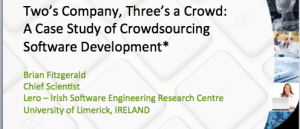Invited Seminar at Open University, 3 Oct 2013

Two's Company, Three's a Crowd: A Case Study of Crowdsourcing Software Development
Crowdsourcing is an emerging and promising approach which
involves delegating a variety of tasks to an unknown workforce i.e.
the crowd. Crowdsourcing has been applied quite successfully in
various contexts from basic tasks on Amazon Mechanical Turk to
solving complex industry problems, e.g. Innocentive. Companies
are increasingly using crowdsourcing to accomplish specific software
development tasks. However, very little research exists on
this specific topic. Our case study highlights a number of challenges
that arise when crowdsourcing software development. For
example, the crowdsourcing development process is essentially a
waterfall model and this must eventually be integrated with the
agile approach used by the company. Crowdsourcing works better
for specific software development tasks that are less complex and
stand-alone without interdependencies. The development cost was
much greater than originally expected, overhead in terms of company
effort to prepare specifications and answer crowdsourcing
community queries was much greater, and the time-scale to complete
contests, review submissions and resolve quality issues was
significant. Finally, quality issues were pushed later in the lifecycle
given the lengthy process necessary to identify quality issues
and have them resolved by the community. Given the emphasis in
software engineering on identifying bugs as early as possible, this
is quite problematic.


